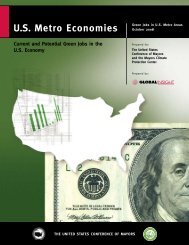Mineral Commodity Summaries 2011 - Environmental and Energy ...
Mineral Commodity Summaries 2011 - Environmental and Energy ...
Mineral Commodity Summaries 2011 - Environmental and Energy ...
You also want an ePaper? Increase the reach of your titles
YUMPU automatically turns print PDFs into web optimized ePapers that Google loves.
164TELLURIUM(Data in metric tons of tellurium content unless otherwise noted)Domestic Production <strong>and</strong> Use: In the United States, one firm produced commercial-grade tellurium at its refinerycomplex in Texas, mainly from copper anode slimes but also from lead refinery skimmings, both of domestic origin.Primary <strong>and</strong> intermediate producers further refined domestic <strong>and</strong> imported commercial-grade metal <strong>and</strong> telluriumdioxide, producing tellurium <strong>and</strong> tellurium compounds in high-purity form for specialty applications.Tellurium’s major use is as an alloying additive in steel to improve machining characteristics. It is also used as aminor additive in copper alloys to improve machinability without reducing conductivity; in lead alloys to improveresistance to vibration <strong>and</strong> fatigue; in cast iron to help control the depth of chill; <strong>and</strong> in malleable iron as a carbidestabilizer. It is used in the chemical industry as a vulcanizing agent <strong>and</strong> accelerator in the processing of rubber, <strong>and</strong>as a component of catalysts for synthetic fiber production. Tellurium was increasingly used in the production ofcadmium-tellurium-based solar cells. Production of bismuth-telluride thermoelectric cooling devices decreased owingto the reduced manufacturing of automobiles containing seat-cooling systems. Other uses include those inphotoreceptor <strong>and</strong> thermoelectric electronic devices, other thermal cooling devices, as an ingredient in blasting caps,<strong>and</strong> as a pigment to produce various colors in glass <strong>and</strong> ceramics.Salient Statistics—United States: 2006 2007 2008 2009 2010 eProduction, refinery W W W W WImports for consumption, unwrought, waste <strong>and</strong> scrap 31 44 102 84 70Exports 4 15 50 8 80Consumption, apparent W W W W WPrice, dollars per kilogram, 99.95% minimum 1 89 92 211 150 210Stocks, producer, refined, yearend W W W W WNet import reliance 2 as a percentage ofapparent consumption W W W W WRecycling: There is little or no scrap from which to extract secondary tellurium because the uses of tellurium arenearly all dissipative in nature. Currently, none is recovered in the United States, but a very small amount isrecovered from scrapped selenium-tellurium photoreceptors employed in older plain paper copiers in Europe.Import Sources (2006–09): China, 49%; Canada, 17%; Belgium, 13%; Philippines, 9%; <strong>and</strong> other, 12%.Tariff: Item Number Normal Trade Relations12-31-10Tellurium 2804.50.0020 Free.Depletion Allowance: 14% (Domestic <strong>and</strong> foreign).Government Stockpile: None.Prepared by Micheal W. George [(703) 648-4962, mgeorge@usgs.gov, fax: (703) 648-7757]







